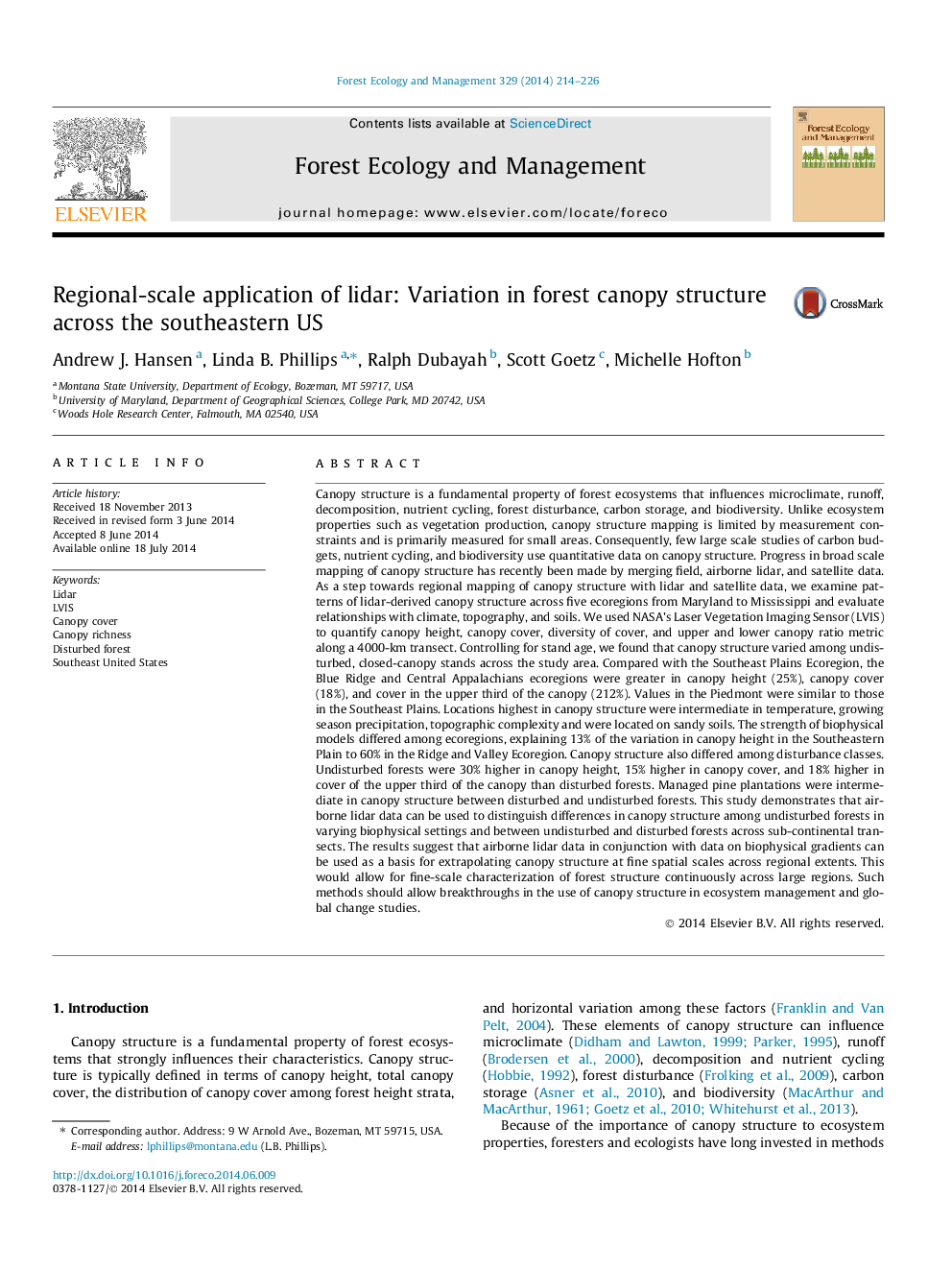| کد مقاله | کد نشریه | سال انتشار | مقاله انگلیسی | نسخه تمام متن |
|---|---|---|---|---|
| 6543422 | 159190 | 2014 | 13 صفحه PDF | دانلود رایگان |
عنوان انگلیسی مقاله ISI
Regional-scale application of lidar: Variation in forest canopy structure across the southeastern US
ترجمه فارسی عنوان
کاربرد منطقه ای در لیدار: تنوع در ساختار سایبان جنگل در سراسر جنوب شرقی ایالات متحده
دانلود مقاله + سفارش ترجمه
دانلود مقاله ISI انگلیسی
رایگان برای ایرانیان
کلمات کلیدی
موضوعات مرتبط
علوم زیستی و بیوفناوری
علوم کشاورزی و بیولوژیک
بوم شناسی، تکامل، رفتار و سامانه شناسی
چکیده انگلیسی
Canopy structure is a fundamental property of forest ecosystems that influences microclimate, runoff, decomposition, nutrient cycling, forest disturbance, carbon storage, and biodiversity. Unlike ecosystem properties such as vegetation production, canopy structure mapping is limited by measurement constraints and is primarily measured for small areas. Consequently, few large scale studies of carbon budgets, nutrient cycling, and biodiversity use quantitative data on canopy structure. Progress in broad scale mapping of canopy structure has recently been made by merging field, airborne lidar, and satellite data. As a step towards regional mapping of canopy structure with lidar and satellite data, we examine patterns of lidar-derived canopy structure across five ecoregions from Maryland to Mississippi and evaluate relationships with climate, topography, and soils. We used NASA's Laser Vegetation Imaging Sensor (LVIS) to quantify canopy height, canopy cover, diversity of cover, and upper and lower canopy ratio metric along a 4000-km transect. Controlling for stand age, we found that canopy structure varied among undisturbed, closed-canopy stands across the study area. Compared with the Southeast Plains Ecoregion, the Blue Ridge and Central Appalachians ecoregions were greater in canopy height (25%), canopy cover (18%), and cover in the upper third of the canopy (212%). Values in the Piedmont were similar to those in the Southeast Plains. Locations highest in canopy structure were intermediate in temperature, growing season precipitation, topographic complexity and were located on sandy soils. The strength of biophysical models differed among ecoregions, explaining 13% of the variation in canopy height in the Southeastern Plain to 60% in the Ridge and Valley Ecoregion. Canopy structure also differed among disturbance classes. Undisturbed forests were 30% higher in canopy height, 15% higher in canopy cover, and 18% higher in cover of the upper third of the canopy than disturbed forests. Managed pine plantations were intermediate in canopy structure between disturbed and undisturbed forests. This study demonstrates that airborne lidar data can be used to distinguish differences in canopy structure among undisturbed forests in varying biophysical settings and between undisturbed and disturbed forests across sub-continental transects. The results suggest that airborne lidar data in conjunction with data on biophysical gradients can be used as a basis for extrapolating canopy structure at fine spatial scales across regional extents. This would allow for fine-scale characterization of forest structure continuously across large regions. Such methods should allow breakthroughs in the use of canopy structure in ecosystem management and global change studies.
ناشر
Database: Elsevier - ScienceDirect (ساینس دایرکت)
Journal: Forest Ecology and Management - Volume 329, 1 October 2014, Pages 214-226
Journal: Forest Ecology and Management - Volume 329, 1 October 2014, Pages 214-226
نویسندگان
Andrew J. Hansen, Linda B. Phillips, Ralph Dubayah, Scott Goetz, Michelle Hofton,
